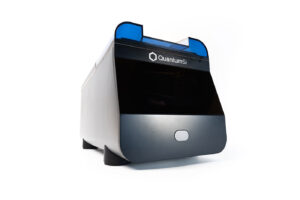Sponsored content brought to you by
Proteins are crucial cellular regulators. Their sequences, structures, and functions are the hallmarks of human health and disease. Nevertheless, despite the proteome’s importance, in-depth exploration of this cellular domain has lagged behind that of the genome and transcriptome.
Transcription does not equal translation; therefore, DNA and RNA are not a direct reflection of the proteins that regulate cell behavior. There are approximately 20,000 parent proteins encoded by the human genome, yet there are over a million distinct proteoforms due to splicing events and post-translational modifications (PTMs). This highlights why genomics and transcriptomics shed little insight into the structure and function of proteins that regulate cell health and disease.1
For decades, approaches such as mass spectrometry (MS), western blots, and enzyme-linked immunosorbent assays (ELISAs) have been broadly used for protein/peptide identification, but have yet to widely broaden access to protein sequencing with the single-molecule resolution needed to understand cell health and disease.
The current gold standard
While MS has been the gold standard for protein identification with peptide-level resolution, several confounding factors can limit the mapping of certain peptides. For example, missed or unanticipated cleavages, chemical modifications, and PTMs can lead to peptides that are not easily detected by MS. Amino acids of identical or similar masses are also difficult to differentiate in standard MS workflows.
Unfortunately, the MS workflow requires costly capital equipment and advanced expertise in operation and data analysis, requiring researchers to use core facilities, which can impose long wait times. Researchers often resort to simpler proteomic techniques such as western blots to detect proteins, with the tradeoff of requiring highly specific antibodies for the protein of interest and not uncovering deeper insights at the amino acid and peptide levels.
Challenges with antibody-based assays
Immunoassays, such as western blots and ELISAs, solve the problem of identifing proteins with an accessible technology; however, immunoassay reproducibility can be challenging due to low-quality antibodies that exhibit cross-reactivity and variability and lack validation for the targeted application.
While select immunoassays with highly specific antibodies have been proven to be sensitive, specific, and convenient for detection of one or multiple analytes in complex samples, they do not provide amino acid–level resolution. Differences at the
single-molecule level are not resolved.
Other technologies that can detect biomarkers at low levels, such as digital immunoassays, may not differentiate between two similar proteins with the same affinity for the same polyclonal antibody.
A paradigm changer
Already in use by leading academic institutions and as reported in Science,2 Quantum-Si’s paradigm changing Platinum™ next-generation protein sequencer is a benchtop instrument that offers a simple workflow and does not require advanced expertise. The use of information-rich signatures of individual N-terminal amino acid (NAA) recognizers’ binding events can provide deeper insight into the proteome.
 Platinum’s workflow is simple and straightforward. Proteins are digested to generate peptide libraries, and peptides are conjugated to macromolecular linkers. The functionalized peptides are then immobilized on a semiconductor chip with exposed N-termini for sequencing.
Platinum’s workflow is simple and straightforward. Proteins are digested to generate peptide libraries, and peptides are conjugated to macromolecular linkers. The functionalized peptides are then immobilized on a semiconductor chip with exposed N-termini for sequencing.
During the sequencing reaction, the surface-immobilized peptides are exposed to a
solution containing dye-labeled NAA recognizers that bind on and off to their cognate NAAs while exhibiting characteristic fluorescence and kinetic properties. Aminopeptidases in solution sequentially remove individual NAAs to expose subsequent NAAs for recognition.
Fluorescence lifetime, intensity, and kinetic data result in a unique signature for each binding event and are analyzed to determine amino acid sequences. Results are automatically transferred to secure cloud-based software for clear-cut
interpretation of results.
Stephen Fried’s lab at Johns Hopkins University was an early adopter of Platinum. “We are a mass spec lab, so we know better than most what the limitations are,” noted Edgar Manriquez-Sandovol, a PhD candidate at the lab. “Platinum allows us to cover those limitations with other experiments that would otherwise never be possible. The throughput is 3X higher than mass spec from our current experiments, and the future of Platinum looks like it is going to reach 10X greater throughput than we are currently seeing.”
Reference
1. www.nature.com/articles/s41592-022-01599-9
2. Reed BD, et al. Real-time dynamic single-molecule protein sequencing on an integrated semiconductor device. Science. 2022 Oct 14;378(6616):186-192. doi: 10.1126/science.abo7651

Learn more about Platinum™ Next-Generation Protein Sequencer
www.quantum-si.com



